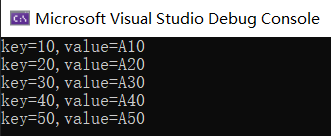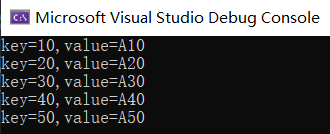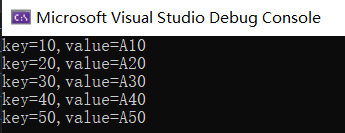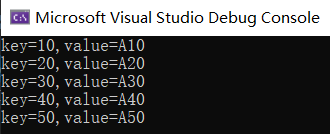您好,登錄后才能下訂單哦!
您好,登錄后才能下訂單哦!
本篇內容主要講解“Dictionary遍歷的使用方法有哪些”,感興趣的朋友不妨來看看。本文介紹的方法操作簡單快捷,實用性強。下面就讓小編來帶大家學習“Dictionary遍歷的使用方法有哪些”吧!
使用 foreach 遍歷
為了方便演示,先上一段測試代碼:
var dict = new Dictionary<int, string>() { [10] = "A10", [20] = "A20", [30] = "A30", [40] = "A40", [50] = "A50" };1. 直接 foreach dict
如果要拿百分比說話,估計有 50%+ 的小伙伴用這種方式,為啥,簡單粗暴唄,其他沒什么好說的,直接上代碼:
foreach (var item in dict) { Console.WriteLine($"key={item.Key},value={item.Value}"); }
這里的 item 是底層在 MoveNext 的過程中用 KeyValuePair 包裝出來的,如果你不信的話,看下源碼唄:
public bool MoveNext() { while ((uint)_index < (uint)_dictionary._count) { ref Entry reference = ref _dictionary._entries[_index++]; if (reference.next >= -1) { _current = new KeyValuePair<TKey, TValue>(reference.key, reference.value); return true; } } }2. foreach 中 使用 KeyPairValue 解構
剛才你也看到了 item 是 KeyValuePair 類型,不過的是 netcore 對 KeyValuePair 進行了增強,增加了 Deconstruct 函數用來解構 KeyValuePair,代碼如下:
public readonly struct KeyValuePair<TKey, TValue> { private readonly TKey key; private readonly TValue value; public TKey Key => key; public TValue Value => value; public KeyValuePair(TKey key, TValue value) { this.key = key; this.value = value; } public void Deconstruct(out TKey key, out TValue value) { key = Key; value = Value; } }有了這個解構函數,你就可以在遍歷的過程中直接拿到 key,value,而不是包裝的 KeyValuePair,這在 netframework 中可是不行的哈,實現代碼如下:
foreach ((int key, string value) in dict) { Console.WriteLine($"key={key},value={value}"); }
3. foreach keys
前面的例子都是直接對 dict 進行 foreach,其實你還可以對 dict.keys 進行 foreach 遍歷,然后通過遍歷出的 key 對 dict 進行類索引器讀取,代碼如下:
foreach (var key in dict.Keys) { Console.WriteLine($"key={key},value={dict[key]}"); }
說到這里,不知道你是否有一個潛意識,那就是 dict 只能通過 foreach 進行遍歷,真相是不是這樣的呢? 要尋找答案,還是回頭看一下 foreach 是如何進行遍歷的。
public struct Enumerator : IEnumerator<KeyValuePair<TKey, TValue>>, IDisposable, IEnumerator, IDictionaryEnumerator { public bool MoveNext() { while ((uint)_index < (uint)_dictionary._count) { ref Entry reference = ref _dictionary._entries[_index++]; if (reference.next >= -1) { _current = new KeyValuePair<TKey, TValue>(reference.key, reference.value); return true; } } _index = _dictionary._count + 1; _current = default(KeyValuePair<TKey, TValue>); return false; }}仔細看這個 while 循環,你就應該明白,本質上它也是對 entries 數組進行遍歷,那底層都用了 while,我是不是可以用 for 來替換然后循環 dict 呢?哈哈,反正就是模仿唄。
使用 for 遍歷
為了把 MoveNext 中的代碼模擬出來,重點在于這條語句: ref Entry reference = ref _dictionary._entries[_index++];, 其實很簡單,_entries 數組內容的提取可以用 Linq 的 ElementAt 方法,是不是~ ,改造后的代碼如下:
for (int i = 0; i < dict.Count; i++) { (int key, string value) = dict.ElementAt(i); Console.WriteLine($"key={key},value={dict[key]}"); }
接下來是不是很好奇這個 ElementAt 擴展方法是如何實現的,一起看看源碼吧。
public static TSource ElementAt<TSource>(this IEnumerable<TSource> source, int index) { IList<TSource> list = source as IList<TSource>; if (list != null) { return list[index]; } if (index >= 0) { using (IEnumerator<TSource> enumerator = source.GetEnumerator()) { while (enumerator.MoveNext()) { if (index == 0) { return enumerator.Current; } index--; } } } }到此,相信大家對“Dictionary遍歷的使用方法有哪些”有了更深的了解,不妨來實際操作一番吧!這里是億速云網站,更多相關內容可以進入相關頻道進行查詢,關注我們,繼續學習!
免責聲明:本站發布的內容(圖片、視頻和文字)以原創、轉載和分享為主,文章觀點不代表本網站立場,如果涉及侵權請聯系站長郵箱:is@yisu.com進行舉報,并提供相關證據,一經查實,將立刻刪除涉嫌侵權內容。